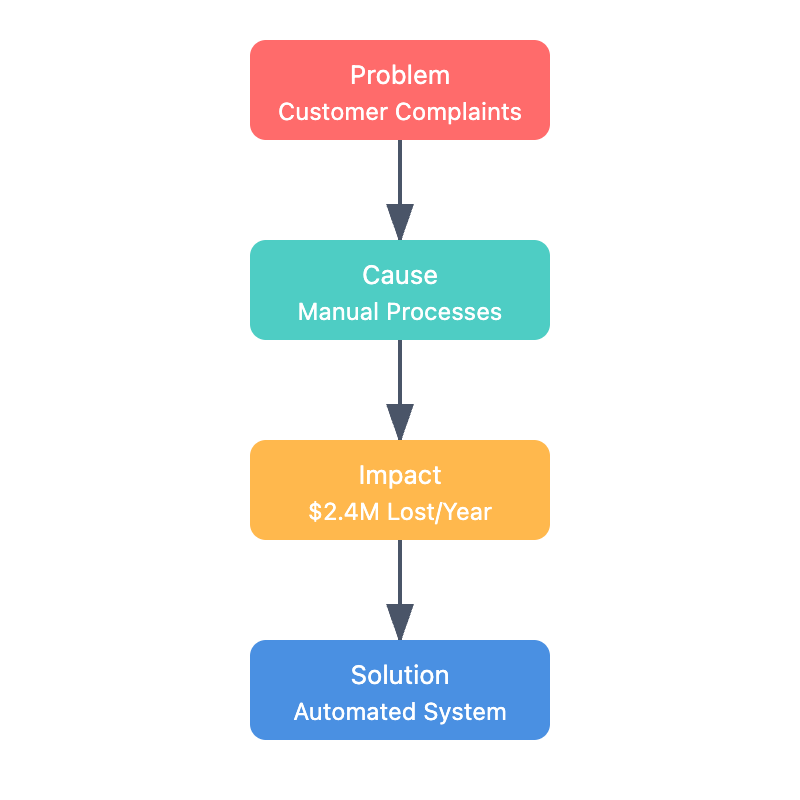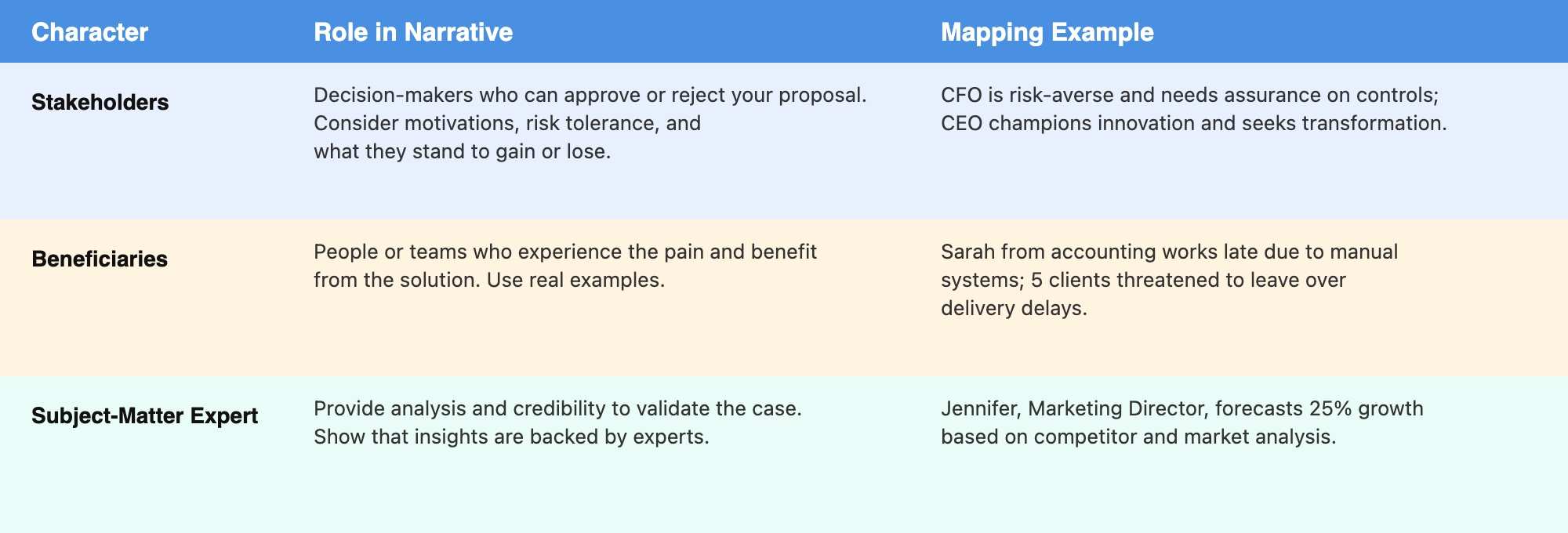Welcome to your journey in mastering the art of building compelling business cases! Throughout this course, you will discover that creating a successful business case isn't just about crunching numbers or filling out templates, it's about telling a powerful story that helps your organization make wise investment decisions.
Before we dive into storytelling, let’s clarify what a business case is and when you need to make one.
A business case is a structured proposal that helps organizations decide whether to invest in a particular initiative, project, or solution. It lays out the reasoning for pursuing a specific course of action by clearly defining a business problem or opportunity, evaluating possible solutions, and recommending the best path forward. Business cases are typically created when significant resources—such as time, money, or people—are required, and when decision makers need to weigh the potential benefits, costs, and risks before committing.
You might be asked to make a business case when you want to launch a new product, invest in new technology, expand into a new market, or even change an internal process. The business case provides a framework for comparing alternatives, understanding the impact of doing nothing, and ensuring that the chosen solution aligns with organizational goals. Ultimately, a well-crafted business case helps leaders make informed, confident decisions about where to invest for the greatest return.
You're about to learn a transformative approach from The HBR Guide to Building Your Business Case that will change how you think about presenting ideas and securing resources. Rather than viewing business cases as dry financial documents, you'll learn to craft them as engaging narratives that capture attention, build understanding, and drive action. This storytelling approach isn't just more engaging—it's more effective at helping decision makers understand the true value of your proposals.
When you develop a business case, you're not just presenting data, you're telling a story about how to meet a business need. This fundamental shift in perspective transforms how stakeholders receive and understand your proposals. Think of your business case as a narrative journey that takes your audience from a current problem to a better future state.
Every compelling story starts with a clear problem or business need that creates tension requiring resolution. The pain point might be "customers complaining about product defects that are damaging our reputation" or perhaps "an outdated IT system causing finance to struggle with accurate reporting" or even "market share lost to competitors offering adjacent services." Whatever the specific challenge, this becomes the driving force of your narrative—the reason your audience should care about what comes next.
Your story needs a well-defined narrative arc that guides stakeholders through the journey. Start by establishing the current state and its consequences, then introduce the path toward resolution. For instance, if you're addressing inventory management issues, your arc might flow from `"incorrect counts disrupting production" through "discovery of root causes in manual processes" to "systematic solution that prevents future errors." This structure helps stakeholders understand not just what you're proposing, but why it matters and how it connects to business outcomes. The visual flow below demonstrates how storytelling might apply in a real-world scenario:

The key to making your business need resonate is grounding it in specific, tangible impacts. Rather than saying "we have an efficiency problem," paint the picture: "Our sales team spends 6 hours weekly on manual reporting instead of selling, costing us $2.4M in lost productivity annually." When you frame problems as stories with clear business needs and consequences, you create an emotional connection that pure data alone cannot achieve. Your stakeholders don't just understand the problem intellectually—they feel the urgency to solve it.
Let's observe how two managers discuss transforming a typical business problem into a compelling narrative:
- Jessica: I'm struggling with my customer service proposal. I have all the data showing our response times are terrible, but it feels so dry.
- Stop thinking about it as data presentation. What's the story? Who's suffering right now?
Just as every story needs compelling characters, your business case must clearly identify the people involved in and affected by your proposal. The HBR Guide emphasizes the following three critical groups of characters, each playing distinct roles in your narrative:

When you explicitly map all these characters, you transform your business case from a solo proposal into a collaborative story that reflects organizational reality. This approach also helps you identify whose support you need, whose concerns to address, and whose expertise to leverage as you build your case. The result is a richer, more credible narrative that resonates with decision makers because it acknowledges the human dimension of business problems and solutions.
The most powerful aspect of framing your business case as a story is exploring different possible endings—the alternatives that answer "What happens if we take this course of action?" Stakeholders don't want to be presented with just one option; they want to understand the different paths available and their respective outcomes.
Each alternative you present represents a different narrative arc with its own resolution. Consider structuring three alternatives that genuinely address the business need in different ways. For instance, if you're addressing customer service delays, you might present "Option A: Implement an AI chatbot system for 24/7 automated responses" alongside "Option B: Expand our offshore support team for extended coverage" and "Option C: Maintain current staffing but optimize processes and training." Each alternative tells a different story about how the organization moves forward, with unique benefits, costs, and implementation challenges.
Critically, one of your alternatives should always be the do-nothing option—the story of what happens if you maintain the status quo. This narrative might unfold as: "If we don't address our inventory tracking issues, we'll continue losing $300K monthly to errors, risk losing our largest client worth $5M annually, and see employee turnover increase as frustration mounts."
This "do-nothing" story makes the cost of inaction tangible and creates urgency for choosing one of your action-oriented alternatives. By explicitly showing what happens without intervention, you help stakeholders understand that even choosing not to act is, in itself, a decision with consequences.
When structuring these alternatives, ensure each option has genuine merit and addresses the business need, just through different approaches with varying trade-offs. Your narrative might show that Option A offers the fastest implementation but highest cost, Option B provides the best long-term value but requires cultural change, while Option C minimizes disruption but may not fully solve the problem.
By presenting alternatives as complete stories, each with their own characters, challenges, and resolutions, you help stakeholders grasp the implications of their decision. Remember that your role isn't to manipulate the choice by offering obviously inferior alternatives. Instead, you're providing stakeholders with genuine options, each telling a credible story about a possible future. The goal is to enable a wise investment decision, not to railroad stakeholders toward a predetermined conclusion.
Now that you understand these fundamental concepts of framing business cases as stories, mapping your characters, and structuring alternatives, you're ready to put these skills into practice. In your upcoming role-play sessions, you'll apply these storytelling techniques to real business scenarios, learning to craft narratives that resonate with stakeholders and drive wise investment decisions.
